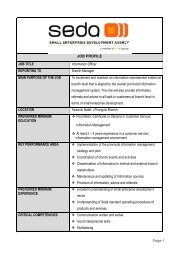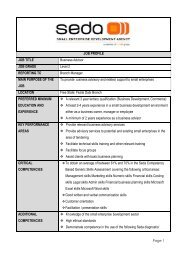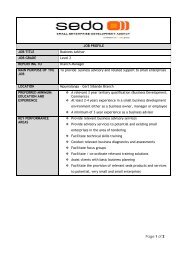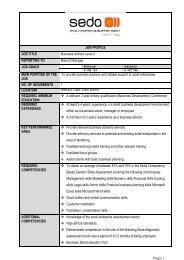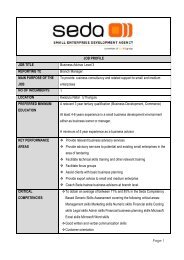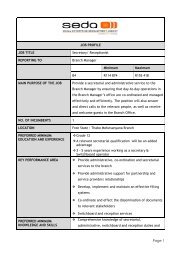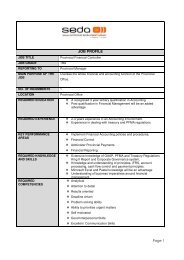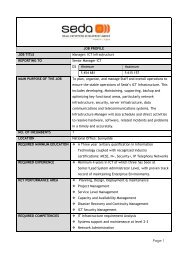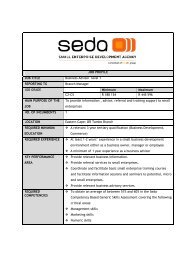Assessment of Cooperatives in the Poultry Industry - 2013.pdf - Seda
Assessment of Cooperatives in the Poultry Industry - 2013.pdf - Seda
Assessment of Cooperatives in the Poultry Industry - 2013.pdf - Seda
You also want an ePaper? Increase the reach of your titles
YUMPU automatically turns print PDFs into web optimized ePapers that Google loves.
Research Report: Address<strong>in</strong>g <strong>the</strong> Needs, Opportunities and Challenges <strong>of</strong> <strong>Cooperatives</strong><br />
and Collectively Owned Enterprises <strong>in</strong> <strong>the</strong> <strong>Poultry</strong> and Related Industries<br />
<strong>Cooperatives</strong> also perceive <strong>the</strong>ir skills <strong>in</strong> manag<strong>in</strong>g employees/staff issues as relatively high. A total<br />
<strong>of</strong> 79% <strong>of</strong> respondents rated <strong>the</strong>se skills as very good or good. This may <strong>in</strong>dicate that amongst <strong>the</strong>se<br />
cooperatives <strong>the</strong>re is not a high level <strong>of</strong> conflict among members. It could also be <strong>the</strong> result <strong>of</strong> <strong>the</strong><br />
low numbers <strong>of</strong> staff. With most cooperatives hav<strong>in</strong>g only one or two staff members, if any, <strong>the</strong>re is<br />
not a lot <strong>of</strong> potential for staff issues. Also, with so few staff members it is easy for staff to<br />
communicate with cooperative members.<br />
Table 4-3: <strong>Cooperatives</strong>’ Skills Rat<strong>in</strong>gs<br />
Manag<strong>in</strong>g <strong>the</strong><br />
cooperative<br />
Manag<strong>in</strong>g<br />
employees/ staff<br />
issues<br />
Very poor Poor Average Good Very good Total<br />
11% 11% 21% 43% 14% 100%<br />
0% 4% 18% 61% 18% 100%<br />
Book<br />
keep<strong>in</strong>g/budget<strong>in</strong>g<br />
18% 25% 21% 29% 7% 100%<br />
Manag<strong>in</strong>g credit 11% 32% 21% 26% 11% 100%<br />
Market<strong>in</strong>g <strong>the</strong><br />
cooperatives<br />
products/services<br />
Apply<strong>in</strong>g for<br />
tenders<br />
7% 25% 21% 43% 4% 100%<br />
84% 5% 0% 11% 0% 100%<br />
Computer literacy 43% 25% 11% 21% 0% 100%<br />
Manag<strong>in</strong>g <strong>the</strong><br />
suppliers<br />
Technical skills<br />
related to <strong>the</strong><br />
cooperative’s<br />
product/service<br />
Manag<strong>in</strong>g<br />
customers<br />
Negotiat<strong>in</strong>g<br />
discounts for bulk<br />
buy<strong>in</strong>g<br />
0% 7% 11% 63% 19% 100%<br />
0% 21% 18% 36% 25% 100%<br />
4% 0% 18% 61% 18% 100%<br />
22% 4% 15% 48% 11% 100%<br />
Product pric<strong>in</strong>g 11% 7% 11% 64% 7% 100%<br />
Source: Urban-Econ Survey, 2013<br />
The table above (4-3) provides <strong>in</strong>sight <strong>in</strong>to how cooperatives rate <strong>the</strong>ir own skills. Vary<strong>in</strong>g levels <strong>of</strong><br />
knowledge understand<strong>in</strong>g can be atta<strong>in</strong>ed as skills develop. A cognitive barrier which makes a<br />
person believe that <strong>the</strong>y understand someth<strong>in</strong>g to a greater degree than is <strong>the</strong> case <strong>in</strong> reality is<br />
called an illusion <strong>of</strong> explanatory depth.<br />
In <strong>the</strong> above Table <strong>the</strong>re may be a problem that many cooperatives are under <strong>the</strong> <strong>in</strong>fluence <strong>of</strong> <strong>the</strong><br />
illusion <strong>of</strong> explanatory depth. This would result <strong>in</strong> <strong>the</strong>m rat<strong>in</strong>g <strong>the</strong>mselves more highly <strong>in</strong> skills than<br />
<strong>the</strong>y are <strong>in</strong> reality. For example, 63% <strong>of</strong> cooperatives reported that <strong>the</strong>y were ‘good’ at manag<strong>in</strong>g<br />
suppliers. However, <strong>the</strong> majority <strong>of</strong> cooperatives reported be<strong>in</strong>g constra<strong>in</strong>ed by high feed costs and<br />
47 | P a g e U r b a n - E c o n : D e v e l o p m e n t E c o n o m i s t s



